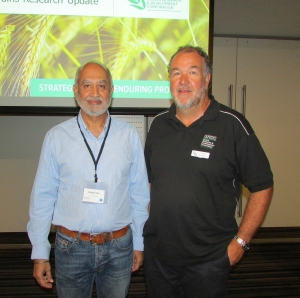Delay the spray if frost is forecast – clethodim advice to growers
Delay the spray if frost is forecast – clethodim advice to growers
Author: GRDC Adelaide office | Date: 18 Jun 2020

Grain growers are reminded they should avoid spraying annual ryegrass with clethodim herbicide during frosty conditions.
Weed control experts are advising growers not to spray clethodim two to three days before or after a frost event due to the impact on efficacy.
The poor performance of clethodim on annual ryegrass – a weed becoming increasingly resistant to clethodim – can be associated with cold and frosty conditions.
Previous research by the University of Adelaide through a Grains Research and Development Corporation (GRDC) investment has shown that frost, particularly before clethodim application, reduces the herbicide’s activity in susceptible annual ryegrass populations.
The studies demonstrated that clethodim efficacy was further reduced in resistant annual ryegrass populations regardless of whether the frost event was prior to or post clethodim application.
However, the impact was much greater when frost occurred before application of clethodim, which is a Group A herbicide.
University of Adelaide Associate Professor in weed and crop ecology, Gurjeet Gill, says frosty conditions make it even harder to control annual ryegrass when clethodim resistance is present in the population.
“Growers are advised to carefully review weather forecasts for their district and spray clethodim when cloud cover is present and the risk of frost occurrence is low,” Dr Gill says.
“Ideally, spray small ryegrass plants under warmer and frost-free periods for the best results with clethodim.
“Stress imposed by frost is a highly significant factor affecting clethodim efficacy on annual ryegrass. We want the ryegrass to be actively growing and stress-free for clethodim to do the best job,” Dr Gill says.
“In many cases, clethodim still provides reasonable ryegrass control provided weeds are sprayed early and at a time when frost is unlikely to occur two to three days before or after spraying,” Dr Gill says.
Dr Gill’s message is particularly pertinent to areas prone to frost at this time of year, when many canola and pulse crops are likely to be sprayed for ryegrass control.
In order to extend the effective life of clethodim, it is important to maintain ryegrass populations at a low level by integrating pre-emergence herbicides and other tactics such as crop-topping, maximising crop competition and harvest weed seed control.
“The use of weed-suppressive hybrid canola can considerably boost overall clethodim performance on ryegrass. Crop competition should be viewed as an ally in the control of herbicide-resistant annual ryegrass,” Dr Gill says.
More information on the impact of frost on clethodim efficacy and research into clethodim resistance can be found in Dr Gill’s GRDC Grains Research Update paper.
Advice on optimising the use of clethodim and other Group A herbicides is contained in the GRDC Fact Sheet.
Further information on in-crop herbicide use is available via the GRDC herbicide behaviour resource portal as well as the GRDC-supported WeedSmart website.
Contact Details
For interviews
Gurjeet Gill, University of Adelaide
08 8313 7744
Contact
GRDC Adelaide office
(08) 8198 8400
media@grdc.com.au
GRDC Project Code: UA00159, ICN 1811-001SAX,
